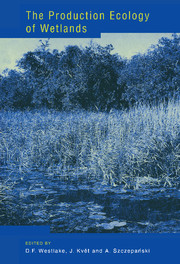Book contents
- Frontmatter
- Contents
- List of contributors
- Preface
- Foreword
- 1 General ecology of wetlands
- 2 Primary production in wetlands
- 3 Further fate of organic matter in wetlands
- 4 The role of decomposers in wetlands
- 5 The role of animals and animal communities in wetlands
- 6 Mineral economy and cycling of minerals in wetlands
- 7 Micro-climatic conditions and water economy of wetlands vegetation
- 8 The management of wetlands
- References
- Index
6 - Mineral economy and cycling of minerals in wetlands
Published online by Cambridge University Press: 27 October 2009
- Frontmatter
- Contents
- List of contributors
- Preface
- Foreword
- 1 General ecology of wetlands
- 2 Primary production in wetlands
- 3 Further fate of organic matter in wetlands
- 4 The role of decomposers in wetlands
- 5 The role of animals and animal communities in wetlands
- 6 Mineral economy and cycling of minerals in wetlands
- 7 Micro-climatic conditions and water economy of wetlands vegetation
- 8 The management of wetlands
- References
- Index
Summary
General characteristics of wetland habitats
Generally speaking, wetland plant communities are so dependent on the chemical processes in their submerged or waterlogged soils (or sediments) that they indicate the chemical properties of their biotopes.
The content of nutrients and other minerals in the aquatic environment depends on the chemistry of the parent rock, subsoil and soil and on the chemistry of the inflowing, running or spring waters. In wetland ecosystems that are managed or interfered with, such as fishponds and farm ponds or aquacultures, or polluted areas in river deltas and estuaries, the degree of either eutrophication or saprobity is decisive.
Wetland biotopes may be classified according to the limnological categories based on the relationship between mineral nutrient contents, and productivity (Thienemann, 1925; Naumann, 1932) as dystrophic, oligotrophic, eutrophic, auxotrophic (Björk, 1967) polluted and saprobic, etc. For the organisms in wetlands the physico-chemical environment, as a whole, is as important as the total nutrient concentration in the aquatic environment; and the ionic interactions (antagonism or reinforcement) are particularly important. A number of wetlands are distinguished by high concentrations of dissolved and suspended organic substances, which act as intense polyionic (macromolecular) buffer systems, functioning on a large scale, especially in the interstitial water of the bottom sediments. The limits of mineral nutrition are therefore not determined by the total nutrient concentrations, but by the absorption capacity of the relevant buffer system for each ion.
- Type
- Chapter
- Information
- The Production Ecology of WetlandsThe IBP Synthesis, pp. 319 - 366Publisher: Cambridge University PressPrint publication year: 1999
- 1
- Cited by



